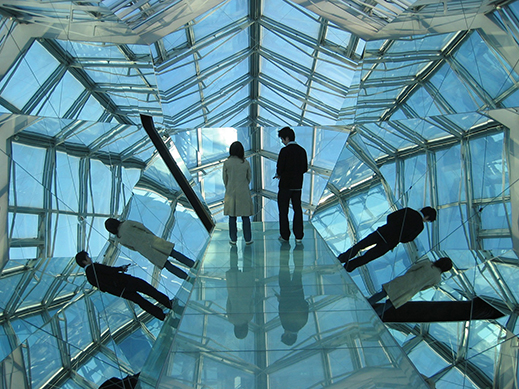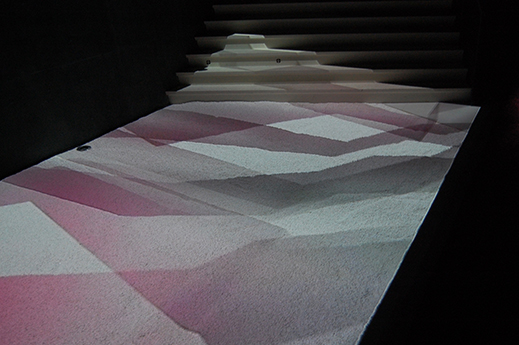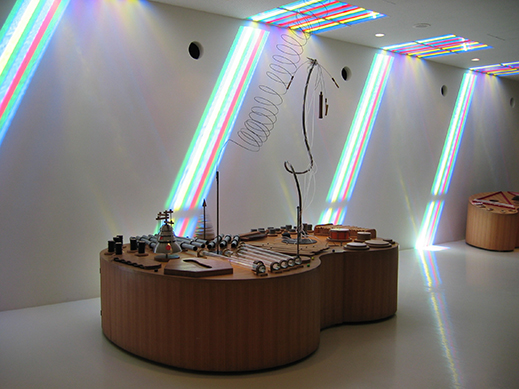|
Aerial view of the Kankaku Museum and Attaka Plaza, with the snowcapped Ou Mountains rising in the background. |
Sitting on the edge of the Miyagi Plain at the foot of the Ou Mountains in northeastern Honshu, the town of Iwadeyama is a bit off the beaten tourist track. People on their way to Naruko, a popular hot springs resort further up the road, generally pass through here without a second look. That's a shame, because Iwadeyama is home to one of Japan's, if not the world's, most entertaining museums.
Opened in 2000, the Kankaku Museum is dedicated to exploring and stimulating the five senses (kankaku in Japanese) through installations that can be enjoyed by young and old alike. Yet despite the appeal of the concept, and the delightful way in which the museum has executed it, the Kankaku seems to have barely registered a blip on the tourism radar, domestic or foreign. Part of this is due to distance -- it is a couple of hours north of Tokyo by Shinkansen -- but insufficient self-promotion may also be to blame. Certainly there is a lack of English-language materials, either online or in print, about the museum. And that's really a pity, because the Kankaku is a rare institution that offers fun for the whole family andknowledge of Japanese to enjoy it.
 |
|
|
|
The Air Traverse, a mirrored promenade onto which you emerge from utter darkness to be surrounded by reflections of sky. |
In keeping with its declared emphasis on sight, sound, touch, and smell (tastes are provided by the small café positioned right among the exhibits), the Kankaku is short on textual explications and long on hands-on experience. Extending in a semicircle around a broad plaza, the facility is laid out as a sequence of installations. The first leads you through a cave-dark passage that forces you to rely on your sense of touch to negotiate, only to suddenly emerge into a blaze of light on a mirrored catwalk that reflects the sky above. Many of the installations use darkness to optimum effect, drawing the eye to the lit objects in the room and the ear to ethereal sounds emanating from invisible sources. One of the loveliest such spaces is the meditative Earth Garden, a chamber where one can sit and watch shifting patterns of color play over a field of white gravel, evoking the changes of the seasons.
 |
|
Earth Garden, a light show by Rie Okumura, takes you on an audiovisual trip through the four seasons. The pink pattern here represents the cherry blossoms of Spring. |
One high-ceilinged gallery is filled with a massive installation by the renowned paper artist Tomoko Ishida. Fragrant Forest is a jungle of hanging vines made from 300,000 pieces of twisted paper. Scattered throughout are tree-like columns with hollows that contain grasses, seeds, leaves and other natural materials from the local woodlands. Stick your head into each hollow for a whiff of one of the gentle yet distinctive scents of the forest.
Fragrant Forest by paper artist Tomoko Ishida, interspersed with pillars whose alcoves emit a variety of scents from nature. |
Also impressive is Space and Sound, a creation of the Tokyo-based experimental architectural firm dNA (for doubleNegatives Architecture). This is a large, cubical anechoic chamber in which the movements of the visitor's body are converted by computer into sounds of varying and unexpected magnitudes and directions.
Light 3D Sculpture, by the product design unit In-Design, features a wall of optical-fiber laced pins with LEDs that light up only when pushed. Visitors press their bodies against the wall from behind to generate the virtual figures seen here. |
But the museum is not all psychedelic sense-disruption. Several installations are designed purely for fun. Yuji Fukui's Circle'n Circle is a huge Rube Goldberg-like contraption that looks like it could be a medieval instrument of torture. Climb onto the three-meter-wide wheel, lie down and start pedadling: while your feet propel the wheel back and forth on a circular track, your hands pull levers that steer the attached stylus to draw chalk "graffiti" on the adjacent wall.
 |
|
Circle'n Circle, a pedal-it-yourself contraption that is much more fun (and safer) than it looks. |
Right next to the wheel is a vast tabletop array of tubes, drums, gongs and other paraphernalia: Hiromi Tada's "Creative Musical Instruments." Instructions are intentionally minimal, but visitors, especially the younger ones, figure out pretty quickly how to create maximal sonic mayhem with these alluring objects. The result is a nonstop, surprisingly mellifluous cacophony by enthusiastic musicians-to-be.
Besides offering its theme park-like panoply of permanent installations, the Kankaku hosts frequent workshops and community events. It is clearly a hit with the locals. On the day I visited, it was not crowded at all, but a sizable contingent of schoolchildren and moms with little ones in tow filled it with an atmosphere of cheerful, noisy vitality.

|
| One of the museum's inviting tables of "Creative Musical Instruments" by Hiromi Tada. |
The museum's appeal to kids of all ages is intentional. Situated in Attaka ("Warm") Village, a spacious riverside campus that includes a hospital, a retirement home, and a community welfare center, it evolved from a master plan conceived by the Japanese government in the bubble-era nineties to build regional facilities that would enhance the quality of life of the nation's rapidly aging population. Some farsighted local politicians were impressed with a "museum of the senses" they visited in Germany and decided to integrate a similar facility into their larger community plan, enlisting the prominent architect Kijo Rokkaku (a disciple of Arata Isozaki) to design the museum. Rokkaku also contributed the Heart Dome, one of the centerpiece installations.
The Heart Dome, designed by museum architect Kijo Rokkaku, is a quiet space conducive to contemplation while sitting in a waterless "bath for the soul." |
In 2006 the town of Iwadeyama, which owns the Kankaku Museum, merged with neighboring municipalities into the much larger city of Osaki. Judging from the impact of similar mergers on local art institutions elsewhere in Japan, I would guess that this change has not worked to the Kankaku's advantage where tourism promotion budgets are concerned. Its mountainside neighbor Naruko, for example, boasts not only hot springs and stunning scenery, but a kokeshi doll museum -- a hard combination to beat.
The museum's "1000 Little Boxes" exhibit is a roomful of 1,000 small drawers, each containing its own tiny mini-installation. Every two years the museum issues a call for submissions, to which anyone can apply to install their own drawer-sized work of art. The Iwadeyama/Naruko region is known for its kokeshi dolls, as seen in the right-hand drawer. |
Though woefully under-promoted, the Kankaku Museum is so unique and so much fun that it merits a trip to this part of Japan on its own terms. For those who need further enticement, however, let me point out that it is perfectly located for a junket around northern Miyagi Prefecture that could include the historic city of Sendai, the famed islets of Matsushima, and of course a long hot soak in the healing waters of Naruko.
Fuwa Pica, an installation by Masaki Yagiwara in which softly lit panels on the wall and the sofa-like object on the floor respond to the touch by changing color. |
| All images are courtesy of the Kankaku Museum. |
 |
|
| |
100 Shimokawara-machi, Iwadeyama, Osaki-shi, Miyagi-ken
Phone: 0229-72-5588
Hours: 9:30 a.m. - 5:00 p.m.
Closed Monday (or Tuesday when Monday is a national holiday) and during the New Year holidays
Access: 7 minutes' walk from Iwadeyama Station on the JR Rikuto Line (transfer from the JR Tohoku Shinkansen at Furukawa Station, two hours north of Tokyo) |
|
|
| |
 |
Alan Gleason
Alan Gleason is a translator, editor and writer based in Tokyo, where he has lived for 30 years. In addition to writing about the Japanese art scene he has edited and translated works on Japanese theater (from kabuki to the avant-garde) and music (both traditional and contemporary). |
|
|
|
|